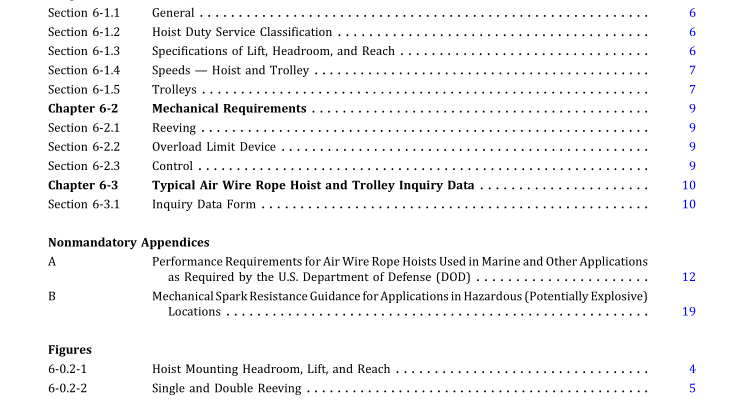ASME HST-6-2020 pdf free download.Performance Standard for Air Wire Rope Hoists
(a) This Standard establishes performance requirements for air wire rope hoists for vertical lifting service involving material handling of freely suspended (unguided) loads using wire rope as the lifting medium with one of the following types of suspension:
(1]) lug
(2) hook or clevis
(3) trolly
(4) base or deck mounted (does not include winches of the type covered by ASME B30.7)
(5) wall or ceiling mounted (does not include winches of the type covered by ASME B30.7)
(b) This Standard is applicable to hoists manufactured after the date on which this Standard is issued. It is not applicable to the following:
(1]) damaged or malfunctioning hoists
(2) hoists that have been misused or abused
(3) hoists that have been altered without authorization of the manufacturer or a qualified person
(4) hoists used for lifting or supporting people
(5) hoists used for the purpose of drawing both the load and the hoist up or down the hoist’s own wire rope
(6) hoists used for marine and other applications as required by the U.S. Department of Defense (DOD), unless Nonmandatory Appendix A is invoked
(c) The requirements of this Standard shall be applied together with the requirements of ASME B30.16. Please also refer to ASME B30.16 for requirements pertaining to marking, construction, and installation; inspection, testing, and maintenance; and operations.
SECTION 6-0.2: DEFINITIONS
abnormal operating conditions: environmental conditions that are unfavorable, harmful, or detrimental to the operation of a hoist, such as excessively high or low ambient temperatures, exposure to weather, corrosive fumes, dust-laden or
moisture-laden atmospheres, and hazardous locations.
ambient temperature: the temperature of the atmosphere surrounding the hoist.
base or deck mounted: a type of mounting where the hoist is mounted to the top side of a horizontal supporting surface.
beam: an overhead standard structural or specially fabricated shape on which the trolley operates.
block, load: the assembly of hook or shackle, swivel, bearing. pins, sheaves, and frame suspended by the rope. This shall include all appurtenances reeved into the hoisting ropes.
brake: a device, other than a motor, used for retarding or stopping motion by means of friction or power means.
brake, holding: a friction brake for a hoist that is automatically applied and prevents motion when the air supply is interrupted.
brake, mechanical load: an automatic type of friction brake used for controlling loads in a lowering direction. This unidirectional device requires torque from the motor to lower a load, but does not impose additional load on the motor when lifting a load. This may also be used as a holding brake if designed as such by the manufacturer.
braking, control: a method of controlling speed by removing energy from the moving body or by imparting energy in the opposite direction.
braking, dynamic: a method of controlling speed by using the motor as a compressor.
braking, mechanical: a method of controling or reducing speed by friction.
ceiling mounted: a type of mounting where the hoist is mounted to the underside of a horizontal supporting surface.
chain, hand: the chain provided to control movement of a hand-chain-operated trolley.
control: a device or group of devices that serves to govern in some predetermined manner the power delivered to the apparatus to which it is connected. .
control, pendant: a valve system, connected to the hoist or trolley by hoses, that either directly controls flow of air to the motor or controls a pilot-operated valve system at the motor inlet.
control, pull: cords or chains suspended from the hoist by means of which a valve system on the hoist can be operated.
control, rod: a rigid rod suspended from the hoist with which a valve system on the hoist can be operated.
cushioned start: a pneumatic or mechanical method for reducing the rate of acceleration of trolley motion.
hazardous (classified) locations: locations where fire or explosion hazards may exist. Locations are classified depending on the properties of the flammable vapors, liquids, gases, or combustible dusts or fibers that may be present, and the likelihood that a flammable or combustible concentration or quantity is present (refer to NFPA 70].
headroom: headroom is measured with the load hook at its upper limit of travel and is the distance from the saddle of the load hook to the following locations (see Figure 6-0.2-1):
[a) centerline of the suspension holes on lug-suspended hoists
(b) saddle of the top hook on hook-suspended hoists
[c) wheel treadline on trolley-suspended hoists
[d) supporting surface on base-, deck-, and ceiling-mounted hoists
[e) uppermost point of hoist on wall- and ceiling-mounted hoists.ASME HST-6 pdf download.ASME HST-6-2020 pdf free download
